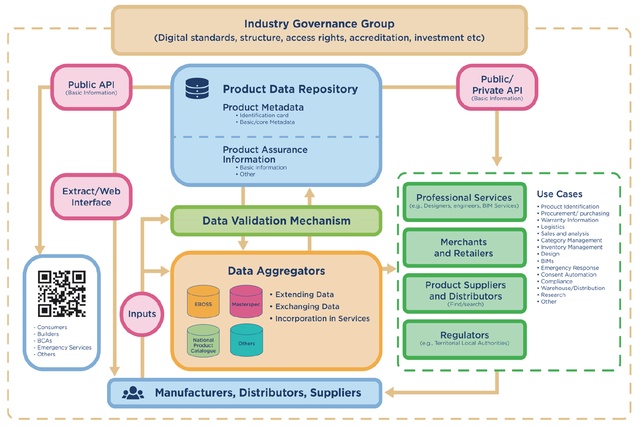Products library holds promise for building sector productivity
A new report on research by GS1 New Zealand – funded by BRANZ from the Building Research Levy and drawing on analysis commissioned from the NZ Institute of Economic Research (NZIER) on international examples of productivity gain from using digital data systems, and GS1 expertise in data standards and related technologies – suggests that the implementation of a national digital database of products could be a solution to the country's lack in building and construction productivity. The organisation's Nick Allison talks about the findings of the report, how these databases are used in other global markets and what it could mean for the future of the built environment.

How much cost can be added to the design stage of any building project because of the time and fiddle involved in searching out the right information on materials and products? How certain can you be that these really are fit for purpose, or that builders on-site will use exactly what has been specified in the plan?
Across the board in the building and construction industry, costs are high. One study by BRANZ in 2017, put the direct cost of fixing or replacing wrongly used (and non-conforming) materials and products at around $232 million annually. That doesn’t include all the costs associated with redesign and reconsenting, and with lost confidence and reputation.
Further research this year has drawn strong links between low quality or non-existent information on products and New Zealand’s abysmal record of productivity growth in building and construction. Analysis of official data suggests average productivity growth per annum of just 0.9 per cent (compare that with 2.2 per cent in agriculture over the same 25-year period).
Much of the problem lies in a lack of accurate, meaningful information that is easily accessed and shared between all parties working on a building project, which can then be available in terms of operating efficiency, product assurance, and technical and business innovation.
Building products library
This latest study suggests that New Zealand can help address its productivity issue and have far greater assurance that products and materials are fit for purpose by moving to a national digital database – a “building products library” that is one verifiable source of truth on product types, attributes, intended uses, warranties, certifications and all else of relevance.
This digital database or library needs to be readily searchable and referenced by builders, building owners and managers, and of course by building designers. Today, most architectural and engineering plans specify the materials and products to be used. How valuable to have a digital tool at your fingertips for identifying exactly the right materials and products, and for ascertaining everything that you need to know about them at the design stage.
What’s more, the architect or engineer can be certain that all other parties – quantity surveyors, building consent authorities, project managers, building supply merchants and so on – have the same product information and the same understanding.
The 2017 BRANZ report highlighted “traceability” as one huge benefit. All materials and products would have a unique identifier that can be scanned off a barcode as they arrive on a building site: Scanning matches physical objects to entries in the digital database and to building plans. You end up with a digital record not only of the plan but of what actually went into the building.
Product library benefits go on and on. The digital data can flow into “building information modelling” (BIM) for many purposes, into resource and building consent applications and decision making, and into whole-of-life building management and maintenance. When professionals are freed from time-consuming information searches and the risks of miscommunication in the building and construction sector supply chain, they can become more efficient and innovative.
Analysis undertaken in the latest study indicates there could be a net economic benefit to New Zealand of $220 million per annum from even a modest take-up of the opportunities by industry professionals and decision-makers.
Structured and standardised data
The critical enabler in such a library is having digital data that is well structured and standardised. Structure and standardisation are what turn the usual “lake” of data found in most organisations into information that multiple parties can use in concert to transform processes and secure real productivity gains: It’s what enables interoperability between organisations and the “network effects” that occur as more organisations take up and make greater use of (structured and standardised) data to the benefit of themselves and all others.
GS1 New Zealand – author of the latest study, entitled “Digital Product data for Lifting Productivity” – is now a product library advisor to the building and construction industry. The global GS1 System for identification of objects, locations and legal entities, and for automatic data capture and exchange, already has wide application in the industry, most notably in the product supply and merchant sector.
Most commonly used materials and products are uniquely identified using GS1-sourced Global Trade Item Numbers (GTINs), aka: barcode numbers. It makes sense, particularly because most are internationally traded. We propose that GTINs be the first element in a New Zealand building products library. Standardised identifiers, scanned from a barcode or read off a radio frequency ID tag, would link the physical object to its “digital twin” within the database. The idea is to start with a core set of standardised attributes for each product that will add quantifiable value to the industry as widely as possible, and to add more information over time as structures and standards for the data involved are agreed upon.

Infostructure
The building products library will require its own “infostructure” including the centralised database (or data repository), alongside mechanisms for inputting and aggregating data, and for validating data before it “goes live” to the industry. Infostructure is a general term for infrastructure (software and hardware) and organisational arrangements that enable a specific information system to function properly.
“Digital Product Data for Lifting Productivity” proposes a building and construction industry infostructure based on open-source international standards as much as possible, and on principles of “market neutrality” and competition in the sourcing of data and in technologies for the accessing of this from the repository. There would be public and private interfaces to enable visibility of different levels of product information, with industry members having the facility to scan products with a smartphone for access to all data over the web.
None of the technology required is new or “cutting edge”, and the infostructure can be designed for interoperability with the existing systems of larger organisations across the industry. GS1 has expertise with data synchronisation technology for enabling the authorised source of particular data to update and augment that data simultaneously across the infostructure from one point, and the upfront technology costs are not high (around $1.5 million).
Industry collaboration
Establishing this infostructure and moving the industry across to such a valuable digital tool will require collaboration that is without precedent. Today, the building and construction industry is fragmented and highly competitive. However, GS1’s research has confirmed there is a generally high level of interest in lifting productivity and in the concept of a building products library. Our recommended approach is to build from a core set of product information attributes around which the industry already has high agreement and to use international technical standards wherever possible.
New Zealand can follow the example of European countries, most notably Sweden, which have developed comparable digital data repositories based on cross-industry collaboration. Here, the infostructure will need to be governed by a truly representative group drawn from across the local industry, and operated as a not-for-profit entity independent of any other commercial interest.
Building designers are key stakeholders in the whole concept. Let’s all work together on the necessary collaboration. We can be confident that support and enthusiasm will grow as more of the industry’s professional groups grasp the potential and then begin seeing the benefits first-hand as a building products library rises from foundational elements that are readily at hand today.
Click here to read the full “Digital Product data for Lifting Productivity” report.










